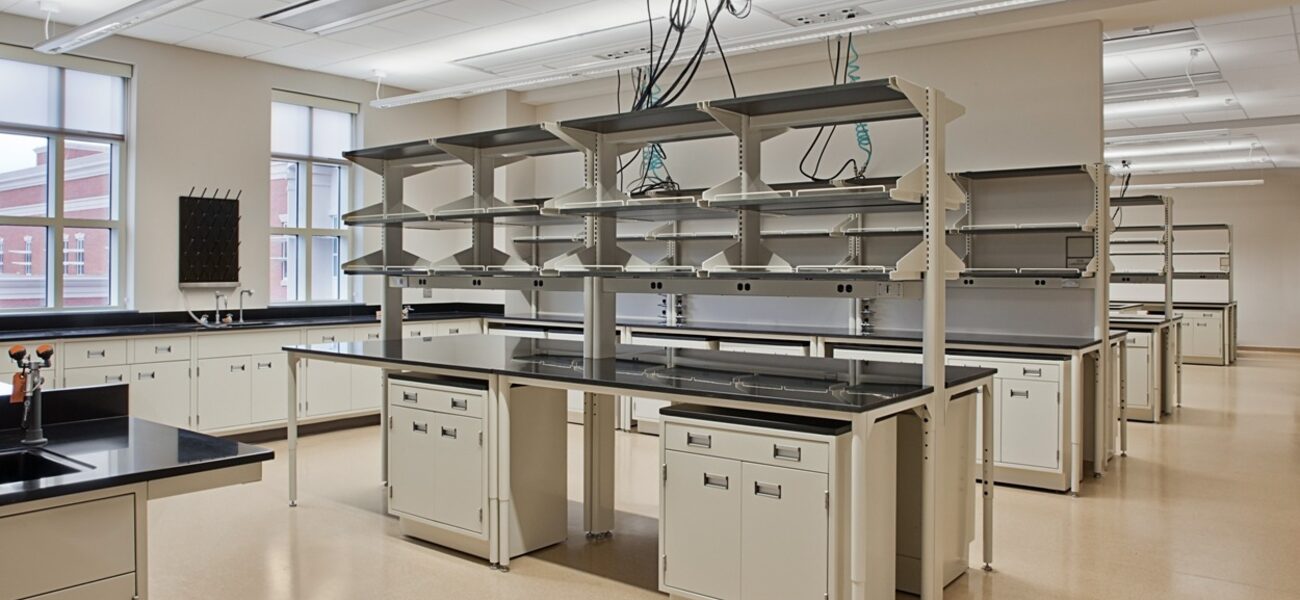The Energy Production Infrastructure Center (EPIC) at the University of North Carolina, Charlotte, brings together the traditional disciplines of civil, environmental, computer, and electrical engineering in a collaborative, innovative research and teaching community. Activities are focused on the development of energy and power production, from microchip fabrication and development of new structural materials to solar and wind power. The facility includes wet and dry research labs for analytical chemistry, trace analysis, DNA, computation, signal processing/communications, microelectronics research and fabrication, laser, and ion processing, as well as fabrication labs, manufacturing and testing labs, Class 1,000 and Class 10,000 cleanroom suites, and a variety of lecture, classroom, and teaching labs for use by the entire engineering and computer science community.
The facility features several specialized research spaces:
The high-bay lab provides critical infrastructure support for a variety of industries, such as energy, construction, transportation, and materials and manufacturing, and can be used by industrial partners as a third-party test environment. Faculty and students design and test resilient infrastructure systems to support the power industry. The lab features equipment to perform full-scale, real-time testing of components and systems using a combination of numerical simulation and experimental testing.
Duke Energy Smart Grid features a real-time digital simulation test‐bed that can perform smart grid device functional testing, system integration, real‐time power system analysis, and under-graduate and post‐graduate education and professional training in grid modernization. Several hardware components for grid-level studies—generator exciters, protective relays, power converters, and smart meters—can be tested under real-time grid conditions. Power amplifiers are used to perform power hardware-in-the-loop testing. Control hardware and software devices are used for testing high-speed communications and real‐time system studies.
The Materials Characterization Lab (MCL) offers university researchers and industry partners access to a range of physical testing, thermal analysis, and materials characterization instrumentation and services. The lab performs a variety of tests on many types of materials to understand how the material responds to specified conditions. The MCL serves a variety of clients, from pharmaceutical and food manufacturers to textile and polymer companies. Common materials include natural and synthetic fibers, metals, and plastics in a solid or liquid state.
The Flexible Energy Laboratory conducts standard compliance and functional performance testing of power and energy systems. The laboratory provides a test and pre-certification environment for low voltage equipment. The lab supports four bays, each capable of supplying 2MW power at voltages up to 690Vac, 1000Vdc. The lab also includes a high voltage area for testing cables, transformers, and other high voltage equipment, and offers infrastructure to conduct water penetration tests, impulse type tests, corrosion tests, dielectric tests, tension/elongation tests, hot set and hot creep tests, and HALT tests.
The Renewable Power Laboratory focuses on de-risking technologies associated with renewable power systems and energy storage, and complements the work done in the Duke Energy Smart Grid and Flexible Energy laboratories. The lab consists of solar array simulators that can mimic power profiles generated either by a single solar panel or a large solar array. Capable of supplying from 35Vdc to 1000Vdc, these simulators can be employed to test the latest panel-level micro-inverters or central solar inverters that support dc link voltages upwards of 800Vdc. This laboratory also uses a 480V, three-phase 250kW, back-to-back three-level converter that serves as a wind power converter simulator. Originally designed for an actual wind power conversion system application, this converter can be controlled with the typical speed and torque profile of a wind turbine.
The building provides landing zones to encourage interaction between embedded industry partnership research teams and visiting faculty/graduate students. These landing zones provide office, lab, and research support to industrial and external academic partners working with the university-based research teams. They provide scientific access and capability while allowing for security of proprietary work.
| Organization | Project Role |
|---|---|
|
Creech and Associates
|
Architect
|
|
Turner Construction
|
Builder
|
|
HERA Laboratory Planners
|
Lab Planning
|
|
McCracken & Lopez
|
MEP Engineers
|
|
LandDesign
|
Civil and Landscape Architecture
|
|
KingGuinn Associates
|
Structural Engineers
|
|
Kewaunee Scientific Corporation
|
Casework and Fume Hoods
|
|
Ametek
|
Solar Array Simulators
|
|
Tektronix
|
Oscilloscopes
|
|
Trane Company
|
Chillers
|
|
SEMCO Incorporated
|
Precondition and Chilled Beams
|
|
Schneider Electric
|
Control System
|
|
Phoenix Controls
|
Lab Controls
|


